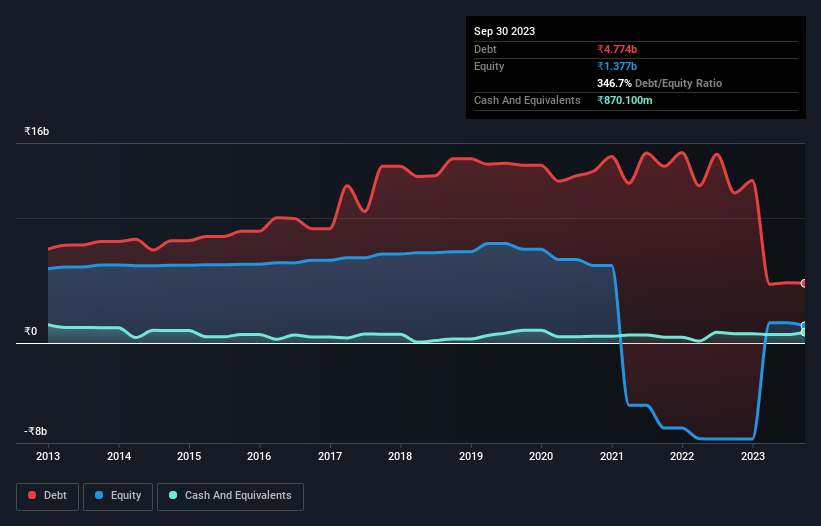- India
- /
- Infrastructure
- /
- NSEI:SICALLOG
Would Sical Logistics (NSE:SICALLOG) Be Better Off With Less Debt?
David Iben put it well when he said, 'Volatility is not a risk we care about. What we care about is avoiding the permanent loss of capital.' When we think about how risky a company is, we always like to look at its use of debt, since debt overload can lead to ruin. As with many other companies Sical Logistics Limited (NSE:SICALLOG) makes use of debt. But the more important question is: how much risk is that debt creating?
When Is Debt Dangerous?
Debt is a tool to help businesses grow, but if a business is incapable of paying off its lenders, then it exists at their mercy. In the worst case scenario, a company can go bankrupt if it cannot pay its creditors. While that is not too common, we often do see indebted companies permanently diluting shareholders because lenders force them to raise capital at a distressed price. Of course, debt can be an important tool in businesses, particularly capital heavy businesses. The first step when considering a company's debt levels is to consider its cash and debt together.
Check out our latest analysis for Sical Logistics
What Is Sical Logistics's Debt?
As you can see below, Sical Logistics had ₹4.77b of debt at September 2023, down from ₹12.0b a year prior. However, it also had ₹870.1m in cash, and so its net debt is ₹3.90b.

How Strong Is Sical Logistics' Balance Sheet?
According to the last reported balance sheet, Sical Logistics had liabilities of ₹2.29b due within 12 months, and liabilities of ₹4.03b due beyond 12 months. Offsetting these obligations, it had cash of ₹870.1m as well as receivables valued at ₹497.5m due within 12 months. So its liabilities total ₹4.95b more than the combination of its cash and short-term receivables.
While this might seem like a lot, it is not so bad since Sical Logistics has a market capitalization of ₹16.6b, and so it could probably strengthen its balance sheet by raising capital if it needed to. But we definitely want to keep our eyes open to indications that its debt is bringing too much risk. When analysing debt levels, the balance sheet is the obvious place to start. But you can't view debt in total isolation; since Sical Logistics will need earnings to service that debt. So when considering debt, it's definitely worth looking at the earnings trend. Click here for an interactive snapshot.
In the last year Sical Logistics had a loss before interest and tax, and actually shrunk its revenue by 13%, to ₹3.3b. We would much prefer see growth.
Caveat Emptor
While Sical Logistics's falling revenue is about as heartwarming as a wet blanket, arguably its earnings before interest and tax (EBIT) loss is even less appealing. To be specific the EBIT loss came in at ₹454m. When we look at that and recall the liabilities on its balance sheet, relative to cash, it seems unwise to us for the company to have any debt. Quite frankly we think the balance sheet is far from match-fit, although it could be improved with time. For example, we would not want to see a repeat of last year's loss of ₹8.5b. So to be blunt we do think it is risky. There's no doubt that we learn most about debt from the balance sheet. But ultimately, every company can contain risks that exist outside of the balance sheet. We've identified 3 warning signs with Sical Logistics , and understanding them should be part of your investment process.
If, after all that, you're more interested in a fast growing company with a rock-solid balance sheet, then check out our list of net cash growth stocks without delay.
New: Manage All Your Stock Portfolios in One Place
We've created the ultimate portfolio companion for stock investors, and it's free.
• Connect an unlimited number of Portfolios and see your total in one currency
• Be alerted to new Warning Signs or Risks via email or mobile
• Track the Fair Value of your stocks
Have feedback on this article? Concerned about the content? Get in touch with us directly. Alternatively, email editorial-team (at) simplywallst.com.
This article by Simply Wall St is general in nature. We provide commentary based on historical data and analyst forecasts only using an unbiased methodology and our articles are not intended to be financial advice. It does not constitute a recommendation to buy or sell any stock, and does not take account of your objectives, or your financial situation. We aim to bring you long-term focused analysis driven by fundamental data. Note that our analysis may not factor in the latest price-sensitive company announcements or qualitative material. Simply Wall St has no position in any stocks mentioned.
About NSEI:SICALLOG
Imperfect balance sheet with very low risk.
Similar Companies
Market Insights
Community Narratives



